
As one of the foremost innovators of competencies, and with 30 years of expertise, we at HRSG have a lot of competency knowledge under our belts.
We could tell you that competencies translate the strategic vision and goals for your organization into the key behaviors that drive organizations forward. That technical competencies can help you drill into the most important skills that individuals need in their roles. And that organizations who utilize competencies have a 55% greater likelihood of increased revenue.
But the world of work is evolving — seemingly, more quickly than ever before. And we wanted to check some of our assumptions with the crowd.
So we reached out to a select group of professionals in the talent management space to get their thoughts. To our knowledge, this is the first comprehensive data set on competency usage that’s been taken in several years, at least — and probably the first ever with a group that’s so knowledgeable about competencies. We think the results are enlightening and informing.
Our respondents identified themselves as:
We also asked them to rate their level of understanding of competencies before digging into the questions. Because we relied primarily on those who had visited the HRSG website in the past, our data set likely contains more expertise about competencies than a random, general sampling of audiences.
Now, onto the data:
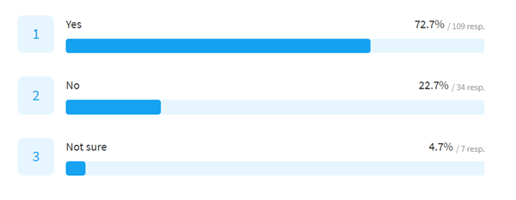
Analysis: Competencies have been heavily adopted since HRSG’s founding in 1989, to the point where almost 3 quarters of our respondents actively use them, in one form or another. It’s easy to see why: Competencies give organizations the power to effectively measure and manage their talent, objectively. We expect this percentage to continually rise as the dawn of the true remote-work or hybrid era fosters the need for increased visibility, measurability and engagement of workforces.
*All survey respondents who currently use competencies
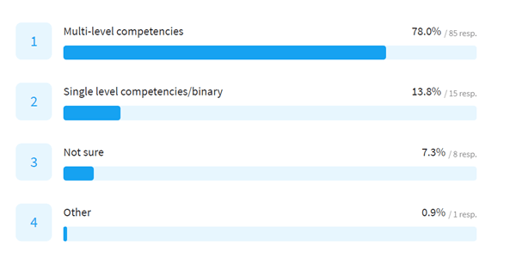
Analysis: The data’s pretty clear: multi-level competencies rule the day. But if you’re not sure what that means, let’s back up a bit.
Single-level competencies offer a binary representation; either someone has the competency in their skillset, or does not. But work, and life, isn’t so black-and-white. To reflect this reality, Multi-level competencies, are more of a gradient (ours use a 5-point scale). This flexibility and detail allows you to map the same competencies at different levels to different level of proficiencies. That makes it much easier to, say, apply core competencies across the board, or show the progression needed between different levels of jobs within the same field. In short, multi-level competencies provide a level of detail that makes them a far more measurable and useful tool in applying competencies effectively.
*All survey respondents who currently use competencies
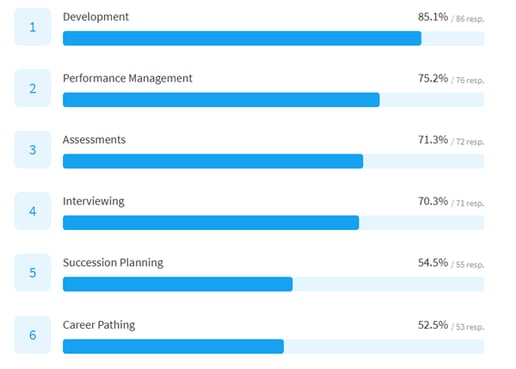
Analysis: Competencies can be used across virtually the entire lifecycle, and the numbers here reflect that. Development activities lead the way with our respondents, but the spread across the board is pretty evenly distributed. Many of these elements tie together tightly; Career Pathing and Succession Planning, for example, can go hand-in-hand. It’s no surprise that Assessment activities are in the top 3 for this question. Once organizations have outlined their competency framework and selected their competencies, the logical next step would be to assess their workforce based on these competencies. The information gained from this important exercise can be used for future HR plans (i.e. Succession planning, performance management, etc.). A shocking discovery is that Career Pathing received the lowest number of responses. This could reflect its ranking in the minds of HR professionals (strategic vs transactional HR focus) or reveal a lack of focus on this aspect of Talent Management (possibly due to the negative impacts of COVID-19 in many industries).
*All survey respondents who do not use competencies
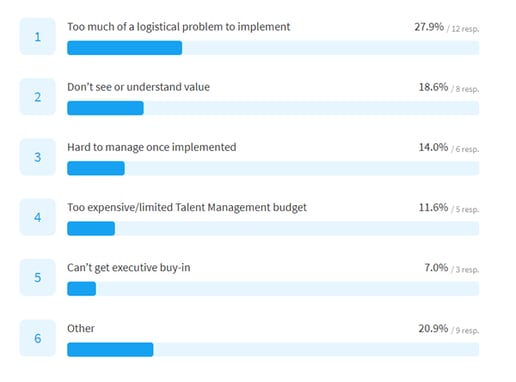
Analysis: For those who aren’t using competencies in their organization — a small percentage of our overall sample — logistics seem to be an issue. Luckily, systems like our own CompetencyCore have made a massive impact on this in recent years. The same goes for managing competencies once implemented.
If you’re looking to understand the value of competencies, our Competency Toolkit is a great place to start; and check out our Convince Your Team page for some tools and resources to help you get executive buy-in with your team.
Select all that apply
*All survey respondents who currently use competencies
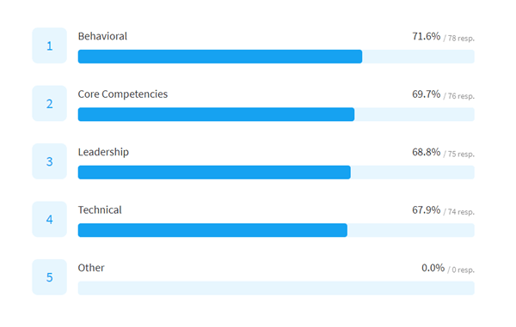
Analysis: All types of competencies have a role to play with our respondents. Behavioral (or ‘universal’ competencies, as we call them at HRSG), define key behaviors and softer skills, whereas technical competencies drill down into specific job knowledge. Most competency profiles attached to a given job will have a mix of these two types on them.
Senior or leadership roles may also have leadership competencies attached — like inspiring others, for example. These capture the transformational traits that help drive organizations forward.
Core competencies are simply competencies that are embodied by every person in the organization; these would most often be behavioral in nature. These competencies should align with or draw their foundation from the core values of the organization.
The most effective competency frameworks make use of all these competency types.
*All survey respondents who currently use competencies
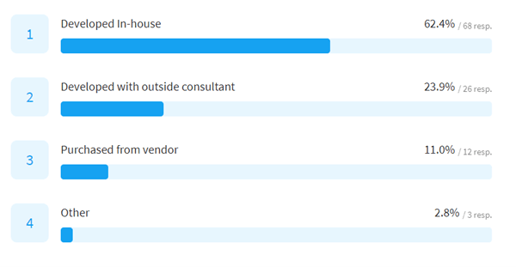
Analysis: This was a question that was surprising in some ways, but perhaps not all that surprising in others. The majority of our respondents developed their competencies in-house; after all, nobody knows your business better than you do.
However, developing competencies in-house does come with its risks — without strong institutional and specialized knowledge on competencies, an organization could use poorly tested competencies as a foundation for their future HR plans. This can lead to complexities and yield little to no benefits for the organization.
*Responses for this question are text-based & have been aggregated for this section of the report. Question only applies to those who indicated they are currently using competencies (earlier in our survey).
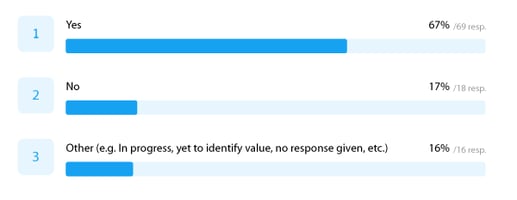
Analysis: Over 65% of those respondents believe they get good value from the competencies being utilized in their organization. One’s perception about the value of competencies depends on several factors, especially their education on competencies. Those who can identify the value of competencies are more than happy to tell you about their viewpoint. Here are a few responses that reflect this:
The 17% who said no cited various reasons for this including poor implementation, confusing information and underutilization regarding competencies.
*All survey respondents who currently use competencies
This was an interesting question which yielded a number of realistic and insightful answers. A point that kept coming up was about the usage of competencies internally. Some respondents mentioned using them for training purposes while others commented on the need to use them for employee development. Applicability was another point which was frequently brought up by respondents. The truth is clear. Having or acquiring competencies does not equate to applying them properly in your organization.
Integrating the use of competencies into an organization’s culture was an interesting insight mentioned by some respondents. Below are just a few of the responses to this question:
*All survey respondents who currently use competencies

Analysis: Here’s where we start to think about putting competencies into action. A key step to implement them and make them matter across your workforce is to build them into your job descriptions. Our respondents seem to be doing this to some extent. A fully-formed, competency-based job description, will generally have core, job family, and job-specific competencies embedded within them. For more info on competency-based job descriptions, check out our extensive guide here.
*All survey respondents who currently use competencies
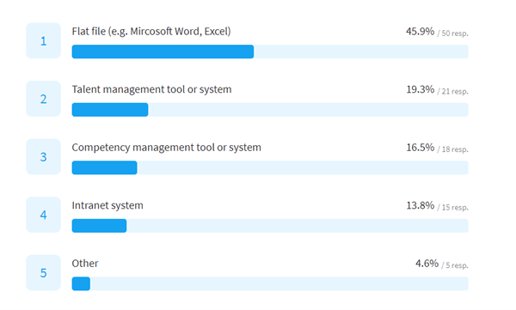
Analysis: As purveyors of what we think is the world’s finest competency management software tool, we were very interested in the results to this question. Most of our respondent’s competencies are living in flat files, which may work for some organizations; however, most companies are using some sort of digital solution these days to turn their competencies into living talent management tools.
*All survey respondents who currently use competencies

Analysis: Effective use of competencies can be highly dependent on getting the people with the right behaviors in from the very start. We were heartened to see that 4 out of 5 respondents said they were using competencies as part of their hiring process. Most often, this would involve asking questions that are directly based on the competencies required for success in the role. Using competencies to enhance your interviewing process can help your organization to help better hire for diversity, remove bias, and select the most competent candidate possible.
Select all that apply
*All survey respondents who currently use competencies
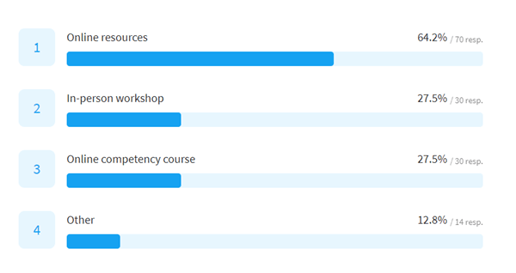
Analysis: There have always been a lot of resources available online to learn about competencies, but the pandemic has forced a lot of more formalized learning online. At HRSG, we adapted our traditional competency training courses into an online environment called Competency Academy. Over 100 HR professionals have enrolled in this unique virtual training program since March 2020.
*All survey respondents who currently use competencies
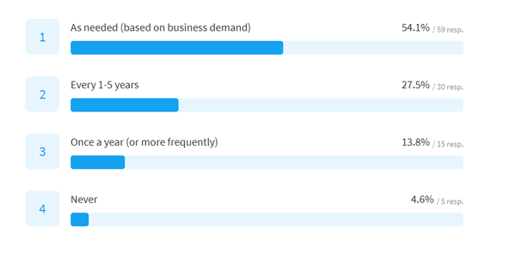
Analysis: The world of work is changing quickly these days. Though most companies are playing it conservative with keeping their competencies updated, over 40 percent are endeavoring to update them on some sort of regular schedule. This is a recommended best practice, to ensure that technical competencies, in particular, reflect the true, evolving nature of the skills and behaviors required.
*All survey respondents
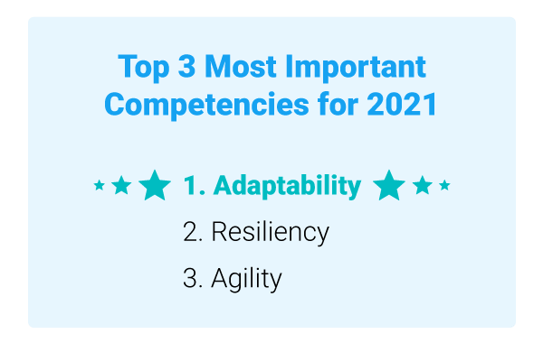
With everything that has happened to organizations during the COVID-19 outbreak, assessing what would be an “important” competency for 2021 was not an easy task. Thankfully, our respondents put forward their best answers and with them, their hopes for a better future. Here are the top 3 competencies which respondents deemed as important for 2021:
We can all agree with the most popular choice here. Some had never heard of this competency. Others had never applied it to this extreme. Regardless, the Adaptability of every individual in the world was pushed to new heights due to the COVID-19 pandemic (both professionally and personally). Adaptability is truly a competency that every employee needs in their career.
*All survey respondents
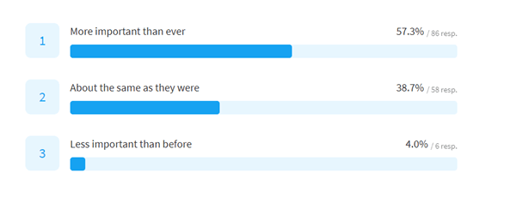
Analysis: The majority of our respondents said that competencies are more important than ever before. With workforces spread out and most white collar organizations forced to adapt to a new method of working and managing employees, competencies have provided the objective foundation to drive the smartest organizations forward.
Map, implement + operationalize competencies with AI
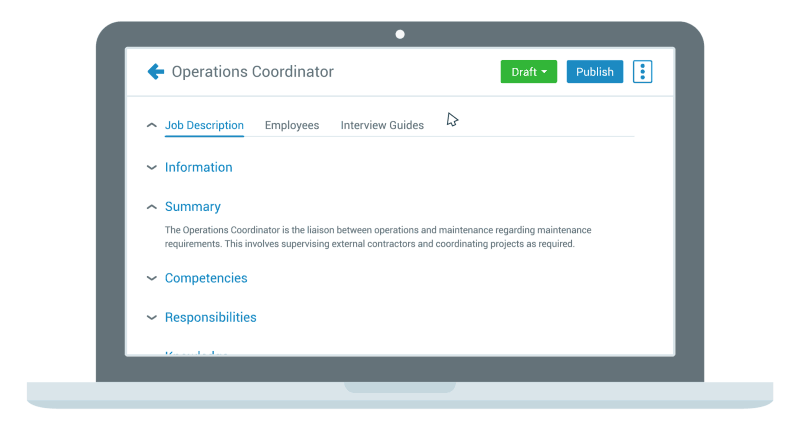
Almost 30% of respondents who don't currently use competencies say that the biggest barrier to using them is that competencies are too much of a logistical problem to implement.
That's why today's smartest HR teams are using CompetencyCore by HRSG to simplify the process of getting competencies into the hands of every employee.
A better way to manage competencies: